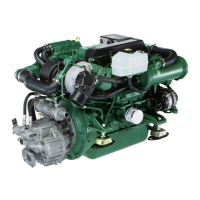20
Operation
Learn how to handle the engine, controls and other equipment in a safe and correct manner before casting off for
your maiden voyage.
WARNING! Avoid violent and rapid rudder movement and gear shifting. There is a risk of the passengers
falling down or falling overboard.
WARNING! A rotating propeller can cause serious injury. Make sure there is nobody in the water before en-
gaging forward/reverse. Never run close to bathers or in places where you have reason to believe there are
people in the water.
123
Check the instruments
Check the instruments and warning display directly after
start and regularly during operation.
Oil pressure
During operation, the oil pressure gauge should show a
reading of 300–500 kPa (43.5–72.5 psi). A lower value is
normal at idling speed. The acoustic alarm will sound auto-
matically in case of low oil pressure.
Coolant temperature
During operation, the temperature gauge should show a
reading of 75–90°C (167–194°F). The acoustic alarm will
sound automatically in case the coolant temperature is too
high.
Charging
During operation, the charge voltage gauge should show a
reading of 28V. The acoustic alarm will sound automatical-
ly in case the charge voltage is missing.
Alarms and fault indication
If the acoustic alarm sounds, one of the warning display
lamps will immediately start to flash to indicate the cause
of the alarm: High coolant temperature (1), low oil pressure
(2) and no charge voltage (3).
IMPORTANT! Stop the engine immediately after an
alarm for low oil pressure. Investigate the cause and
rectify it.
Slow the engine speed to idle/disengaged after an alarm
for high coolant temperature. If temperature does not drop,
the engine must be stopped. Investigate the cause and
rectify it.

